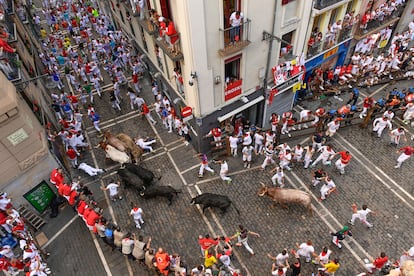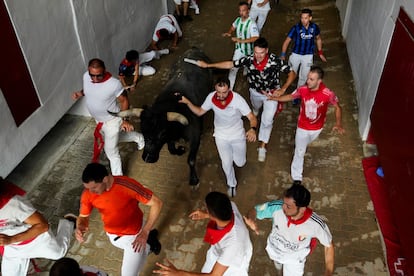The San Fermin bull runs are, year after year, the focus of heated controversy over their loss of identity, a longing for a past overflowing with emotion. Today’s races, it is said, are adulterated, the bulls seem trained, elite athletes trained for a fast, crazy, clean and noisy 850-meter race in which they barely make their way through a crowd drunk with excitement and adventure. It is insisted that today’s bull runs are predictable and boring, you see one and you’ve seen them all; they are no longer what they were, they are not interesting.
It’s true. The breeders, in their constant search for an animal with mobility and longevity in the third part of the muleta, force their bulls to undergo hard training in the pasture where they sweat and sweat in specially prepared corridors until they achieve muscular and agile bodies for the very hard test of bullfighting. And those chosen for Pamplona, with even more reason: to participate in that long escape through the streets at full speed and without time for discouragement.
In addition, in 2005, the City Council of the capital of Navarre found a miracle product to reduce the danger of the running of the bulls: a non-slip liquid that is used to water most of the route and makes the hooves of the animals and the shoes of the humans grip the cobblestones and reduce slips and falls.
Thus, between the physical training of the bulls and the sticky ground, the bull runs have changed their appearance. Now, they are said to be boring.
But what has really changed in the San Fermín bull runs?
The big news is that the morbid curiosity, the blood, the addictive vision of how a python tears the flesh of a runner and gores him mercilessly while the spectator enjoys a spectacle of real, skin-deep violence, and does not care if his first coffee of the morning gets cold, have disappeared.
That is the emotion that is missed, the lost beauty that is now demanded.
The bulls are the same, huge, with long horns, brave, dangerous… A force of nature; accomplished athletes, yes, but animals that carry danger in their blood; and the runners have taken turns over time, but they maintain the same objective: to live an experience in the form of an adrenaline bomb, to savour the colour of risk, to feel like heroes for a moment and to outwit, if possible, the threatening and thin-horned horns.
That’s it damn you It is the non-slip liquid that prevents the bulls from slipping on a surface that is strange for their hooves, from ending up with their anatomy on the ground, from losing touch with reality and feeling alone, lost, far from their herd. Because that is the moment of true danger in the San Fermín bull runs. That animal that gets up, confused, disoriented and harassed by the crowd, feels the need to defend itself from the mob; and that defense is the possible preamble to an angry rain of blows, blows, terrifying headbutts and goring knives that fly through the air.
He is the living image of Olivito, a Miura bull that ran on July 14, 2014. He lost his balance at the beginning of Estafeta Street, felt alone and helpless, and unleashed his fury on Jason Gilbert, an Australian who was visiting Pamplona for the first time. First, he slammed him against the wall, and in the angry struggle he slashed one of his thighs from top to bottom, he viciously chased him to the fence, where he gored him again until the groom managed to get away from the animal. And he was not the only one injured that Olivito left that morning. This was an unforgettable bull run because of the bloody drama of the images. It is not every day that you have the opportunity to enjoy a thigh that is opened up without the need for special effects.
But this violence brings nothing to the running of the bulls; it is not the blood that is the origin of the race or what gives it meaning, but the bull in the street and the possibility of feeling like a hero with the tips of your fingers.
Furthermore, today’s running of the bulls, less bloody and spectacular, is just as dramatic and dangerous as those of yesteryear. The data are there: in the eighties, the number of people injured by bull horns ranged from two in 1984 to nine in 1980; in the nineties, between three in 1998 and 12 in 1994, and one runner killed in 1995; in the first ten years of the 21st century, between four in 2008, 16 in 2004, and one death in 2003 (these figures set off alarm bells and Pamplona City Council agreed to spray the surface of the route with non-slip liquid, which did not prevent another death in 2009), but between 2010 and 2019, the number of people injured ranged from two in 2018 to 12 in 2016. Finally, in 2022 there were six; three the following year and two in 2024, the same as in 1984 and 2016.

What has changed then? The morbid curiosity, which many confuse with emotion, has disappeared.
Today, the running of the bulls has returned to its origins: a bullfight heads towards the bullring on foot, and the most daring locals run alongside them. Many young men bite the dust, and some, the least, feel the burning nail of a horn in their flesh. This is how the running of the bulls of San Fermín has been and continues to be today, despite the controversy over security and blood in the foreground. Without a doubt, violence does not make them more exciting.

